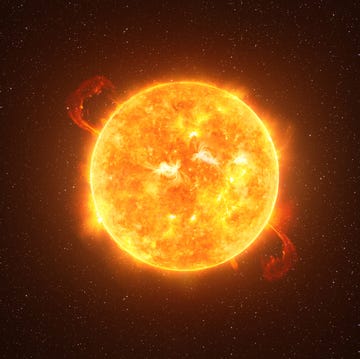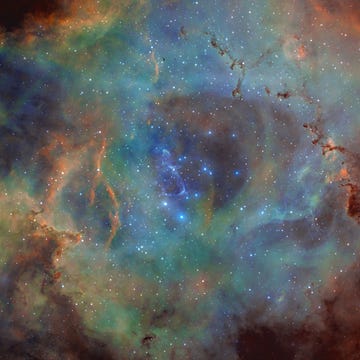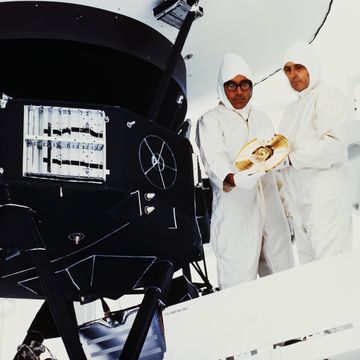In the 2013 movie Europa Report, a crew of astronauts probes the ice of one of Jupiter's largest moons, Europa, when (spoiler alert!) they run into lethal alien life. The scenario isn't so far fetched, Arizona State University planetary scientist Jim Bell tells PM (at least not the part about looking for life on Europa).
"It is, even more than Mars, the next closest place in the solar system besides the Earth where there could be not just life but complex life, because the ingredients are there," he says.
Beneath the crust of water ice that covers the surface of Europa—which is a bit smaller than our own moon—there lies a vast, salty ocean containing more water than all of that on Earth. Tidal forces created by the pull of Jupiter's gravity keep the water from freezing and provide heat that could be a boon life for life. Plus, Europa has essential biological ingredients like sulfur, nitrogen, and carbon.
So if there is life down there, how in the heck will we find it?
At last, NASA has a plan to visit this enticing world. On May 26, the space agency announced it had chosen the instruments that will go onto a spacecraft that to be sent to Europa in the 2020s. Cameras will map close to 90 percent of the moon's surface at a resolution of 164 meters per pixel and gather individual images up to 100 times more detailed during a two-to three-year mission. (The spacecraft will orbit Jupiter in an elliptical orbit, instead of the moon itself, in part to save fuel.) During its 45 flybys of Europa, the spacecraft will fly within 16 miles of the surface at its closest approach, and as far away as 1,700 miles. It will also probe beneath the ice with radar, estimate its thickness and salinity with magnetometers, attempt to discover the composition of the brown (possibly organic) gunk on the surface, create heat maps, measure the rarified particles that make up the moon's nearly non-existent atmosphere, and maybe even sample a water plume by flying through it.
NASA's 2020s Europa mission may indeed clinch the case that the moon has all the necessary ingredients for life. But if life is there, this mission probably won't find it.
"We don't have a life detector," said Curt Niebur, NASA's Europa program scientist, during the press conference announcing the mission's scientific instruments. "It would be wonderful if we would see chlorophyll, like you see in Earth plants. But we're not going to see chlorophyll. Mother nature is not going to be that kind to us. It would be great if we would see fossilized bones sticking up out of the surface. That's not going to happen."
To really know what's going on in Europa's ocean, we'll have to get closer to it. A lander would be a logical next step—one that would be part of a as-yet-unplanned future mission that would be guided by the new data. From the surface, a Europa lander might even be able to send a probe into the ice.
"Getting down to the liquid water is what everyone dreams about," says Cody Youngbull, another Arizona State University researcher.
But getting through the ice to the water below will be a major challenge. At -260 degrees Fahrenheit, the ice is hard and it may be miles thick. The best thing that could happen would be if the 2020s mission were to find chinks in Europa's armor in the form of cracks or holes in the ice. If there are no obvious weakness, though, then mission planners might have to try an alternative plan.
"The simplest way to get under ice is not to have to go through it at all, but to enter from the edge," says Andy Bowen, Manager of the National Deep Submergence Facility at the Woods Hole Oceanographic Institution. Barring that, an autonomous underwater vehicle might have to melt its way through the ice using heat generated by a radioisotope thermal generator, Youngbull says.
If NASA can get a probe down below the surface, exploring Europa's hidden ocean presents a host of other challenges, starting with how to power the ET-hunting robot and how it could communicate with the Earth or with another spacecraft. Bowen imagines a scenario in which a robot unspools a fiber optic line like spider silk behind it as it sinks beneath the ice, providing a hardwired connection to the lander that spawned it, and from which data could be transmitted back to Earth. Even if the ice refreezes around the line, it would still provide a conduit back to the surface.
It won't be easy, Bowen says. "You would certainly want to make sure that you understood that ice." For example, mission planners would want to know whether icequakes were common. "A little bit of that would ruin your day because a very fragile glass fiber doesn't take much to snap or cleave off." Assuming that didn't happen, though, Bowen says the line could also carry a trickle charge of power from the lander as well as providing a relay for images and other data.
Youngbull would want a Europa oceanic explorer to carry high-speed, high-definition, hyperspectral cameras to record the maximum amount of information possible from down in the moon's bowels. And the probe would need a way to light up the perpetual darkness beneath the ice, so tunable laser and broadband excitation light sources would be needed. In addition, he would like to see a miniature, low-power mass spectrometer for detecting metallo organic molecules—that is, organic molecules that include metals—in the water. "Life as we know it needs water and metals," says Youngbull. "What are the metal concentrations in Europa's oceans?"
A chiral liquid chromatography would also be useful (and could work in concert with the mass spectrometer), Youngbull says, for detecting the chirality (or "handedness") of molecules in the ocean. Life on Earth follows displays a homochiral preference, or single-handedness, in its molecular structure. "Finding such a preference in the waters of Europa would be a strong indication of biological metabolism" he says.
Finally, he would want a digital droplet polymerase chain reaction instrument, because this tool could hunt for nucleic acid sequences that might also indicate life. "Such an instrument does exist, because I build them in my lab."
Europa isn't the only tantalizing place to hunt for life in the solar system. Saturn's moons Enceladus and Titan may also have subsurface oceans, and so might Europa's fellow Jupiter moons of Ganymede and Callisto. The European Space Agency is planning a Jupiter moon probe of its own, called JUpiter ICy moons Explorer (JUICE), to be launched in 2022 and perform flybys of Ganymede and Callisto in addition to Europa. In the next decade, maybe we'll finally get a peek at these weird and wonderful places.














